1969-1986 Ford Capri
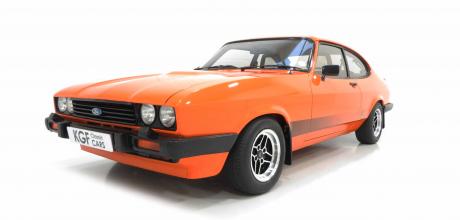
How Ford’s personally augured vehicle prospered in the Mustang’s shadow. Words: David Osborne.
THE STORY OF FORD’S EVERYMAN COUPE
Facts, figures and history on the car which brought the Mustang magic to Europe.
FORD CAPRI (1969-1986) THE MARKETPLACE / THE CARS / THE BEGINNING
To understand the significance of the Capri one must first appreciate the impact of the Mustang and the precedent it set within Ford. Clothing workaday running gear in a body the masses could afford proved wildly successful at its launch in April 1964; US management in Dearborn, realising the precedent, set out to build a European equivalent – a coupé based on existing platforms and running gear, freeing up funds to create a new bodyshell and marketing campaigns to maximise its appeal.
DEVELOPMENT
Retaining the equine theme, Project Colt was born, hot on the heels of the Mustang, towards the end of 1964: rapid development saw a stretched Corsair platform used as the basis for the new car, as Dearborn decided that the upcoming Escort was too narrow for the range of engine options planned.
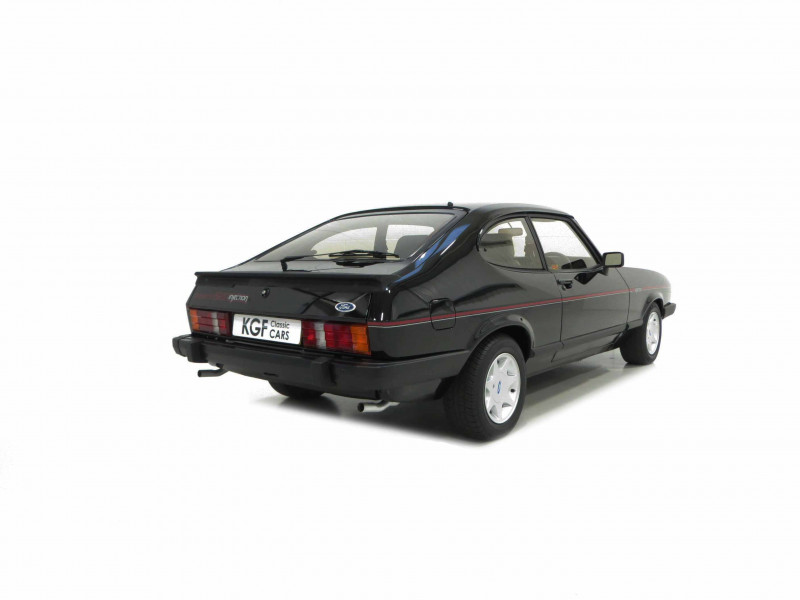
Further work took place nailing down the details: the new car went from a two-seater to a four-seater and within a year an Advanced Vehicle Design mock up had been sent to Europe, with the new UK centre in Dunton, Essex taking the lead in refining the details.
Ultimately, it would be Mustang team member, Philip T Clark, who took the main credit for the Capri’s shape; customer clinics, which took place in London, Brussels, Milan, Cologne, Hamburg, Geneva and Amsterdam refined the C pillar window design away from its original hockey stick profile as two GRP models, dubbed ‘GBX’ and ‘Flowline’, were wheeled out in front of potential buyers.
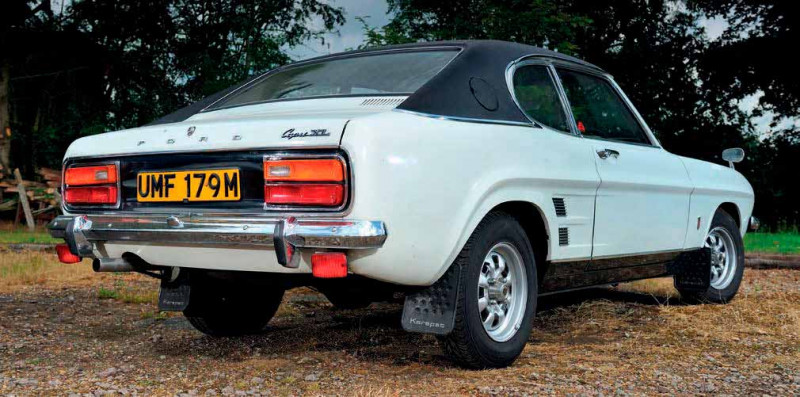
The Mustang influence in the Mk1 is obvious. C-pillar styling was changed at the last moment.
Project Colt was signed off in July 1966, and slated for an Earls Court, London debut in October 1968 – but this eventually slipped to January 1969, when the new car appeared at the Brussels motor show. Response to the so-called ‘C curl’ rear window was so negative that, based on feedback from clinic members, worried about visibility for passengers, prompted tooling to be changed relatively late in the day. Additions from other departments also delayed the launch. The original plan to build the car solely at Halewood became complicated when Ford Germany wanted to fit Cologne V4s and V6s from the Taunus; duplicated tooling would be sent to Germany to build the new car there, too.
Ford dropped the Colt development name from the boot lid of the new car when it realised Mitsubishi had the rights to the name; realising it couldn’t take the moniker into production, it reverted to a name it already owned: Capri, previously used on the 1962-1964 Consul Capri designed by Ford of Britain.
PRODUCTION/SALES
While Halewood and Cologne were tasked with the job of building the Capri from the outset, Ford’s satellite plants soon got in on the action. Cars were also built in the Australian suburb of Homebush from 1969, and, by 1970, the Escort factory in Saarlouis, Germany, was in on the job, alongside Port Elizabeth in South Africa.
The engine range kicked off with the 1.3-litre ‘Kent’ crossflow, (1300/1300GT) with the 1.6-litre Kent (1600/1600GT) the 2-litre V4 (2000GT) and the 3-litre, 128bhp Essex V6 from autumn 1969 (3000/3000GT). Over in Germany the range relied on the V4 engines, in 1.3, 1.5 and 1.7-litre capacity, with the V6 offered as a 2-litre and 2.3.
In the finest Ford tradition, the options list was extensive and allowed buyers to personalise the car. Marketing for the cars was centred around the concept of what the MkI brochures called ‘Capri Custom Planning’, with three specification levels offered for both models from the factory: L, X or of course XL. GT buyers, meanwhile, could specify the R Plan which brought sports steel rims, fog lights, special paint and black grille to the party; combining them all gave you an XLR. Said brochures also listed a wide range of individual options, from cloth trim to automatic gearbox. The whole thing was a brave attempt at allowing a customer to individualise their car; cribbed directly from the Mustang’s marketing strategy, it brought an hitherto-unprecedented level of choice to the customer, regardless of their budget.
It was confusing though: there were some 32 different combinations of engine and trim level, so the MkI brochures picked out eight favourites for you.
EVOLUTION Mk I (1969-1974)
The Capri was a raging success: more than 400,000 were sold in its first two years of production.
It wasn’t long before performance variants began to appear in the Capri line up, but not everyone stuck with the 3-litre Essex V6.
Closest to home was the 3000E in 1970. E stood for Executive; billed as a luxury variant of the Essex-engined Capri V6, it was the most ambitious that the Mk1 Capri got, in the UK at least. To underline its status, this most opulent of Capris couldn’t be paired with any of the Custom Plans, but recipients got a vinyl roof, cloth insert seats and opening rear windows.
Basil Green Motors, a race car workshop in South Africa, began transforming locally built Capris in 1970 by adding an engine option otherwise unavailable to the rest of world: a 5.0-litre Windsor V8 normally found in the Mustang. It had taken barely a year for the Capri and Mustang to converge mechanically, though in truth, Basil Green’s Capri Perana, as the model was known, also included running gear from the Australian Ford Falcon XW.
Peranas could be ordered from a South African Ford dealer and came with factory warranties; if purchased, a Capri 3000 XL was sent out from Port Elizabeth without an engine and gearbox to the Basil Green works.
Ford Germany, instigators of the Rallye Sport moniker a few years earlier with the Taunus 15M, released the RS2600 in September 1971. Using the smaller, stiffer Cologne V6 engine in place of the 3000E’s Essex engine the RS2600 featured Weslake cylinder heads and Kügelfischer mechanical fuel injection for a headline 150 bhp. A homologation special for European touring car racing, it also featured modified suspension with gas Bilsteins, alloy wheels and uprated brakes as well as lightweight bodywork and sports bucket seats. A less radical, detuned carburettor-fed version was subsequently introduced bearing the name 2600GT.
Around the same time, a cut-price alternative to the RS2600 appeared using the 2.6-litre Cologne: the May Turbo. Designed by Swiss Formula Junior champion and forced induction specialist, Mike May, the May turbo kit lifted peak power to 208bhp, with an electronic ‘tuning box’ responsible for ignition timing.
By 1972, Ford authorised a facelift; front and rear ends were refreshed, the 3-litre ‘bonnet bulge’ became standard across the range, and suspension specifications, were altered, with an rear anti-roll bar added. A revised facia, and two-spoke steering wheel, also appeared.
A year later, the first right-hand drive RS Capri arrived – the RS3100. Using the same quad-headlight front ends as the 3000GXL, the replacement for the RS2600 was another touring car homologation special – with a bored-out Essex V6 replacing the Cologne. Riding an inch lower than other Capris, the RS3100 featured shell modifications, an air dam and rear duck tail spoiler, flared wings and gold pinstriping, together with heavy duty Bilstein suspension. With 1000 declared built, closer to 248 were built between 1973 and 1974 to satisfy homologation requirements.
In August 1973, a significant milestone was reached: the one-millionth Capri was built.
CAPRI II (1974-1977)
In February 1974, the original car was updated into the MkII, or Capri II as Ford named it. More than a facelift, the changed involved some significant changes to the bodywork, which gained a shorter bonnet and increased width, with the biggest change being the addition of a hatchback, a body configuration which began to gain popularity across Europe. Bigger side windows, more sound deadening and the option of power-steering further broadened the Capri’s appeal.
Capri II was released with an updated dashboard and folding rear seats were also added, with the car now offered in L, XL or GT flavours, with 1.3, 1.6 or 2-litre Pinto engines plus the 3-litre V6. Capri II continued unchanged apart from the legendary JPS-liveried black-and-gold (or white-and- gold) special edition until it became the Mk III in 1977.
The spirit of the Executive returned with the 2.0 and 3.0 Ghia editions; features included alloy wheels, tinted glass, a tilt-or-slide sunroof. and special bodyside mouldings. October 1975 welcomed in the ‘S’, a halfway-house specification for 2.0 and 3.0-litre models.
Sales were beginning to decline slowly across Europe, so production was reorganised; Halewood, the only other plant producing Capri IIs apart from Cologne, ran down its lines, with the German factory made solely responsible for Capri output from October 1976, The car was still popular in the UK, even if a seven-year stint in the US, where it sold at Lincoln- Mercury dealers, had not proved as successful as hoped, despite more than 500,000 cars having been exported there since its debut at the 1970 New York Motor Show.
While the Capri II may not have featured as prominently on the race track as its predecessor, it appeared prominently in TV programmes, including The Professionals and Minder; the former featured a performance X Pack kitted car, though subsequent episodes made more of a star of the Mk III 3.0S.
The Series X and X Pack options range were launched throughout 1977 and 1978, aimed at boosting the appeal of the Capri to serious drivers. A wild fibreglass arch, skirt, wheel and spoiler kit, along with a host of Rallye Sport engine upgrades, could be had from dealers for both Capri II and MkIII; while expensive and slow-selling, completed cars remain sought-after by fans; Capri Club International produced a reproduction kit available to members and non-members.
MkIII (1978-1987)
Although 1978’s Mk III (Project Carla) was little more than a heavy facelift of Capri II, it was an attempt to keep the model competitive in the face of the newer, front-wheel-drive opposition like the Scirocco and Manta; the UK, it must be emphasised, still adored the car. The engine range was initially carried over from Capri II, and serious attention had been paid to aerodynamics in the creation of its successor. A reshaped bonnet, spoiler and a louvred bonnet grill helped improved performance from an initially unchanged engine line up, though by 1981 the 3.0-litre Essex V6, mainstay of the 3.0S, had been replaced by the Bosch fuel-injected Cologne 2.8.
Ford’s Special Vehicle Engineering group was entrusted with developing the Capri 2.8i model, which first appeared at the 1981 Geneva Motor Show with lowered suspension, thicker anti-roll bars, gas-filled shock absorbers, and wide-rim alloy wheels fitted with Goodyear 205/60VR NCT tyres to keep the Capri competitive. A five-speed gearbox (from 1983) and limited-slip differential (from 1984) made for a tempting proposition; publications heaped praise on the car.
1981 welcomed back forced induction to the German Capri range – albeit helped by a third party. Inspired by the wild Zakspeed racers of the time, Rallye Sport Deutschland added a Garrett T4 turbo to a Capri 3.0S, garnishing the package with Series X bodywork, deep dished RS alloys and special Ford Motorsport spoilers front and rear. Bilstein dampers all around, an anti dive kit, uprated RS anti roll bars and single rear leaf springs completed the package; with 188bhp on tap, the end result was a laggy, unsubtle GT of considerable ability. Around 155 cars were converted, all in left-hand drive.
A year later, Aston Martin Tickford offered an extensive and expensive turbocharged transformation of the Capri in an attempt to bring more work into its increasingly idle workshops. Rebuilt in house by the coachbuilder, a Capri Injection went in one end; 200 hours later, a hand built, leather trimmed, 205bhp Simon Saunders bodykitted wonder emerged. The end result divided opinion like no other: between 80 and 93 cars, excluding prototypes and cars bought to convert, were built.
The same year watched as the once-enormous Capri range reduced down: the LS, S and 2.8i. LS and S models gained the 2.8i-based interior, while the ‘S’ received similar suspension to the 2.8i.
1984 saw the 2.8 Injection Special introduced, with an optional LSD and stiffer suspension, half-leather seats and RS-styled seven-spoke alloys, along with the ‘Laser’ trim range.
By 1984, the Capri was lagging behind in a market which wanted more than leaf springs and a pushrod V6; European sales were discontinued. ironically, sales remained sufficiently strong in Britain for the Cologne factory to continue production from 1984 to 1986 in right-hand drive form only for the UK market, the last examples being registered in 1987.
A special run-out model was produced to mark the event, the Capri 280, which was essentially a 2.8 Injection with LSD, full leather Recaro interior, 15-inch RS alloys and special Brooklands Green paint which gave them the nickname ‘Brooklands’.
The Capri’s swansong was the ‘280’, more commonly known as the Brooklands.
The 280 was essentially a 2.8 Injection with LSD, leather Recaros, RS alloy wheels and Brooklands Green paint.
The hatchback Capri II was the sole major bodyshell revision during the entire life of the Capri.
UREN STAMPEDE: THE OTHER V8 CAPRI
Basil Green Motors weren’t the only firm offering V8-converted Capris; while the South African firm bowed out of uprating these cars in the early Seventies after local production of the Mk1 ended, the scene was ripe for other tuning firms to step into the void.
Enter Race Proved Performance and Equipment Ltd, in Hanwell, London, which is thought to have V8-transplanted eight Capris in the mid-Seventies.
Founder, Jeff Uren, had a long history with Ford; its erstwhile competition manager, he formed Race Proved in 1967 after previously winning the British Saloon Car Championship in a Zephyr, and campaigning Cortinas, GT40s and Cobras with John Willment earlier in the decade.
Uren also undertook V6 conversions to the Cortina Mk II, known as the Savage; his transformed Capris, however, were known as Stampedes. Like the Perana Capris, the Stampede conversion made use of the Mustang Boss 302’s 5.0-litre Windsor V8 albeit supplied in a higher state of tune than by Basil Green. Uren also fitted a four-speed ‘top loader’ manual from the American car but retained the rear axle and other running gear from the V6 Capri on which the Stampede was based.
Just one of the eight Uren Stampedes is known to survive, built for wealthy Greek car enthusiast, Stelios Fafalios, who was also commissioned its wild metalflake paintjob His car began life as an ex-Ford management Capri II 3-Litre automatic, but was transformed in 1975. Uprated suspension, 14-inch wheels, four-pot brake calipers, and a stiffened shell helped the car cope with the reputed 320bhp produced by the gas-flowed and blueprinted V8.
Performance was impressive: Motor quoted a 5.8 second 0-60, and a £5000 purchase price – more than a Jaguar E-type. Race Proved could perform the V8 transplant on Mk1 Capris, too; Fafalios’ car is the only known modified Capri II in period.
FERGUSON FORMULA: THE ONLY ALL-WHEEL DRIVE CAPRI
All-wheel drive had long figured in Ford’s plans for rallycross and the Capri – still in development – was regarded as an ideal candidate to receive the new technology.
Henry Taylor, Ford’s competition manager, noticed how rally Escorts struggled in deep mud, and pondered if all-wheel-drive running gear, pioneered by Ferguson Formula, could be the answer.
Rallycross proved to be the crucible for further development, as rallying forbade four driven wheels in competition; it wouldn’t be until the late Seventies before the FIA relented.
Barely a fortnight after the Capri had debuted in Brussels, Roger Clark had taken the wheel of a prototype FF Capri at Croft, near Darlington, winning all three events that it entered.
The car represented more than a year of development; Harry Ferguson Research had received two prototype Capri 1600GTs from Taylor in 1968, and the lessons learned were then applied to a V6-engined car. A new subframe was needed to contain the drivetrain, and more than 170lb of hardware added to the Capri’s kerb weight.
Clark, however, was unimpressed with the car, complaining that, despite its 40/60 torque split, that the Capri exhibited terminal understeer and that its Dunlop Maxaret anti-lock braking system interfered with racing lines.
Interest in the FF Capri died down until the autumn of 1970; with World Cup Rally requirements met, and with a new competition manager, Stuart Turner, in Henry Taylor’s seat, three all-wheel drive Capris were further developed to contest the 1970/1971 ITV/Castrol rallycross season and TEAC series at Lydden Hill, in Kent.
The earlier cars had used single-carburettor Essex V6s with around 160bhp; in terms of long-term competitiveness, this simply wasn’t enough to shift the extra bulk of the running gear, so fuel injection was employed. Two of the three cars, built for Rod Chapman and Stan Clark, had between 212 and 230 bhp; Roger Clark’s car, complete with aluminium cylinder heads and Lucas fuel injection, managed 252 bhp.
Unreliability chipped away at the cars’ effectiveness; problems with the all-wheel- drive hardware, particularly from the front driveshafts, were legion, and the fuel-injection systems gave trouble. Lydden Hill organisers, in deference to the two-wheel-drive cars on the grid, handicapped the Capris by five seconds; visibility was so bad for the cars following that it simply wasn’t possible to gain a competitive advantage, even with the supreme driving talent on offer. That none of the drivers thought much of the cars dynamically was a further issue; Roger Clark described the Capris, thus equipped, as ‘absolute pigs to handle.’ Ford, however, still had plans for FF’s all-wheel-drive hardware, considering it an attractive option for a roadgoing 3-litre Capri.
Plans were drawn up for GKN to manufacture a variant of the FF all-wheel-drive running gear on Ford’s behalf; complete with Maxaret anti-skid brakes, the notion of a cut-price Jensen FF would have made for a tantalising proposition in the late-Sixties and early-Seventies.
In the end, the sums didn’t work for Ford: its accountants reckoned Capri customers would baulk at spending an extra £145 (projected costs) over a 3-litre, despite the obvious advantages the system conferred.
Not that it stopped FF from converting Capris privately – records vary, but between 16 and 18 cars were converted in period, with 12 of those sent to the USA; Simon Haberman of FF4 Automobiles Limited, New York, imported the cars.
Ford fans have since upgraded other Capris – including Capri IIs and MkIIIs – with Sierra XR4x4 running gear.
PHILIP T CLARK: CAPRI GODFATHER
While many names come up during the Colt development programme that led to the Capri – Gil Spear, Bob Bordinat and Bob Maguire, among others – it was Philip T Clark whose work is now most recognised in the final design of the Capri.
Clark, along with Maguire, was sent to Ford of England – alighting in its then-new Dunton, Essex design and engineering centre – in 1964 to develop Project Colt further.
Clark found himself in the largest facility for Ford trucks and cars in Europe; its extensive workshops allowed the creation of GRP models far closer in fit, finish and appearance to that of a production car, and those of competitor’s models shown alongside. Previously, customer clinics had to make do with clay mock-ups, which were laborious to make and hard to transport.
It was in 1965 that the essential Capri shape — save for that essential side window detail – was created by Clark at Dunton. That GRP model, known as ‘GBX’, was received incredibly well by customers across Europe, and helped greenlight Project Colt for production in 1966.
Having had considerable input into the Mustang’s design, his most recognised work from that programme was the galloping horse emblem that later became an icon; he was later credited with the exterior of the Transit and worked on designs from Ford of Germany’s Merkenich studios under Uwe Bahnsen and Hans Muth. The Iowan passed away tragically at the age of 32 owing to kidney failure, having not received due credit for his role until 2010 until his daughter, Holly Clark, began reassembling his portfolios.
Clark was duly inducted into the Ford Capri Hall of Fame that year by the Capri Club of North America; its executive, Norm Murdock, runs an Ohio-based specialist Capri firm, Team Blitz, which supports Capri owners and enthusiasts in the United States.
Sadly, the ‘Capri Girl’ advertised on the door is nowhere to be seen. Liverpool Ford dealer J Davy’s lavish launch for the new car.
TICKFORD TURBO – THE CAPRI ASTON MARTIN PROMISED
With demand for the Capri still strong in the UK, thoughts turned, in the early Eighties, to producing a high-performance variant of the 2.8 Injection.
Where SVE stopped, Aston Martin-Tickford came in. Test driver and journalist John Miles wanted Ford to consider a customised, turbocharged Capri 2.8i as a swansong for the model; it would be retired before the Eighties were out.
Miles, who previously honed the chassis of the Uren Stampede, felt that the Tickford division of Aston Martin was more than up for the task of taking the Capri into a new market – but Ford management reshuffles killed off any chance of the car coming ‘in house.’
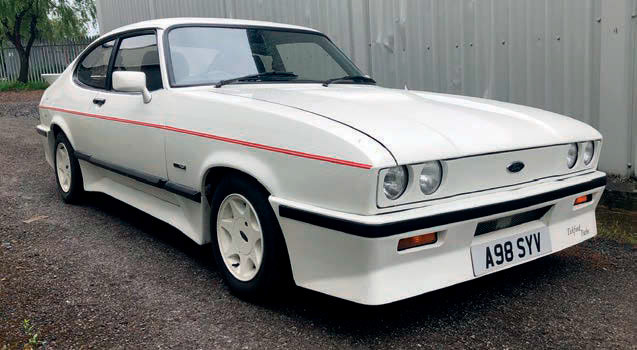
Undeterred, Aston Martin-Tickford invested in the concept itself, bringing completed Capris into the fold and rebuilding them by hand at its own facility before Tickford’s Bedworth, Warwickshire works were finished to build later cars. An extensive aero kit transformed the 2.8i’s appearance – and under the bonnet, a custom designed, front-mounted IHI RHB6 turbo installation upped power to 205 bhp. Peak torque was quoted at 260 lbf.ft.
A modified ignition system from the Escort RS1600i was fitted to avoid detonation; supplied by AFT, the arrangement allowed Tickford to retain the Cologne’s 9.2:1 compression ratio, backed by a larger radiator, oil cooler and oversized Garrett intercooler.
The induction system required considerable modification to the engine bay, which increased the build costs per unit – the front ‘grille’ and air dam took six hours in itself to complete on the factory floor.
Lessons learned from the Tickford Capri Turbo were later incorporated into stock Capri drivetrains. Engineers felt that the running gear wasn’t up to the task, so improved the lubrication between the five-speed gearbox input shaft and main shaft.
A better limited slip diff, with up to 40 per cent lock, was also specified – superior to that offered by Ford itself as an option and later as standard; a finned diff cover also kept operating temperatures down. Solid rear discs, based on those from a Peugeot 504, were also added to the rear – Ford still used drums on the 2.8i at that point. Aft suspension was also braced to stop lateral movement; the front Bilsteins of the standard car were kept.
Much work was also to done to lift the Capri’s interior – from improving the door seals to quell noise at high speed to a fully wood and leather trimmed dashboard. A matching centre console was fitted, complete with switches for the electric windows, a Veglia clock and a boost gauge from Lucas.
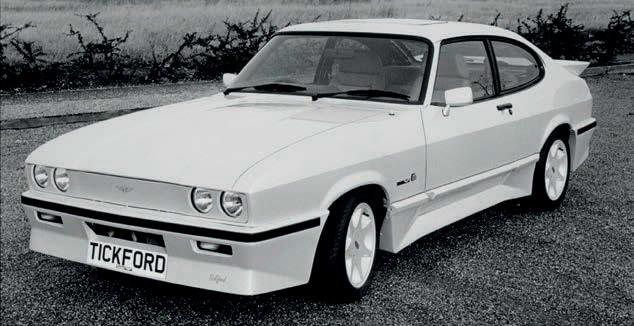
Options were extensive, and costly: a full Wilton carpet and leather retrim could be had if the customer specified it.
Announced in 1983, the Tickford Capri Turbo appeared twice in official Ford literature the following year, depicted next to the standard Capri 2.8i. Reviews were favourable, particularly where performance and driving dynamics were concerned; the 2.8i and Special were well-respected performance cars, despite the advancing age of their running gear, and adding a well-engineered turbo installation to the mix did little but improve the Capri’s station. Much of the criticism centred around the bodykit, which was an acquired taste for some.
Taking 200 hours to build before extras were added, the Tickford Turbo Capri rang the tills at £14,985 that year – the equivalent of an inflation corrected £51,000 nowadays.
The ongoing demise of the Capri itself didn’t help matters; despite later cars being based on the 2.8i Special, few enthusiasts saw the appeal in spending serious money on a Capri, no matter how exquisitely modified. 1987 was the final year for the Tickford Turbo Capri, then listed at an eye-watering £18,581. A final Limited Edition in a fourth colour, known as Flaxen Mist, did little to improve matters — a single car was built in this colour. As Ford wound down production in Cologne, so too did the Tickford Turbo Capri end its run; Tickford’s Warwickshire works were soon redeployed to work on the Sierra RS500 Cosworth. Aston Martin-Tickford had planned to build 400 cars; this was later revised to 250 and in the end, 93 cars were built.
| MODEL | CAPRI MK1 1300 | CAPRI II 3.0S | CAPRI MKIII 280 |
| ENGINE | 1296cc 14 | 2994cc V6 | 2792cc V6 |
| MAX POWER (ВНР) | 52/5000 | 138/5000 | 160/5700 |
| MAX TORQUE (LBF.FT) | 66/2500 | 174/3000 | 163/4300 |
| TRANSMISSION | 4sp man | 4sp man/3sp | 5sp man |
| LENGTH (MM) | 4262mm | 4286mm | 4439mm |
| WIDTH (MM) | 1645mm | 1695mm | 1698mm |
| HEIGHT (MM) | 1288mm | 1295mm | 1323mm |
| KERB WEIGHT (KG) | 888 | 1116 | 1230 |
| MAX SPEED (MPH) | 86 | 123 | 127 |
| 0-62 MPH (SECS) | 19 | 8.6 | 7.9 |

